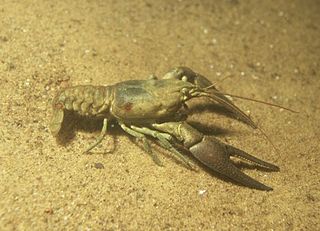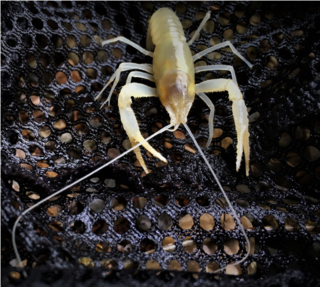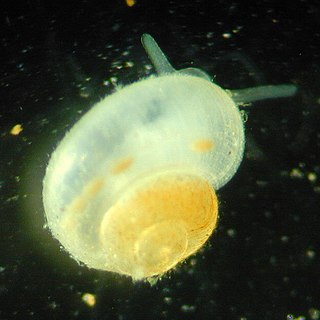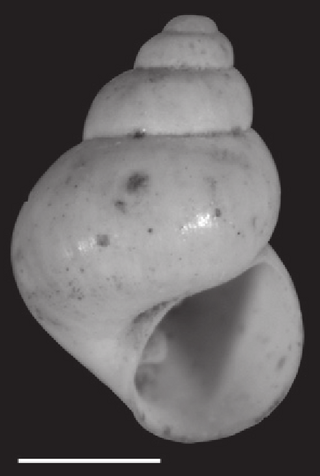Antrorbis breweri, common name Manitou cavesnail, is a species of freshwater snail with gills and an operculum, an aquatic gastropod mollusk in the family Lithoglyphidae.
The Ichetucknee siltsnail, also known as the sand grain snail, scientific name Floridobia mica, is a species of small freshwater snail, an aquatic gastropod in the family Hydrobiidae. This species is characterized by its association with bryophytes and eelgrass, with females typically being larger than males. The snails show sexual dimorphism, and their population includes both adult and juvenile individuals, indicating active recruitment. The majority of specimens are juveniles, identified by having one to one and one-half whorls.
The phantom cave snail or phantom cavesnail is a species of very small freshwater snail with an operculum, an aquatic gastropod in the family Hydrobiidae.
Fontigens is a genus of minute freshwater snails with an operculum, aquatic gastropod molluscs or micromolluscs in the family Hydrobiidae.
The mimic cavesnail, scientific name Phreatodrobia imitata, is a species of very small or minute freshwater snail with a gill and an operculum, an aquatic gastropod mollusk in the family Hydrobiidae.
Phreatodrobia is a genus of very small or minute freshwater snails with a gill and an operculum, aquatic gastropod mollusks in the family Lithoglyphidae.

Pyrgulopsis is a genus of freshwater snails with a gill and an operculum, aquatic gastropod mollusks in the family Hydrobiidae.
The San Bernardino springsnail is an endangered species of freshwater snail in the family Hydrobiidae. This species is endemic to a small number of springs in the USA and northern Mexico.
Marstonia castor, common name the beaver pond marstonia, is a species of very small freshwater snail with a gill and an operculum, an aquatic operculate gastropod mollusc in the family Hydrobiidae. This species was endemic to a very limited area of the US state of Georgia, mostly to streams and creeks around Lake Blackshear.
Brune's tryonia, scientific name Tryonia brunei, is a species of very small freshwater snail that has a gill and an operculum, an aquatic gastropod mollusc in the family Hydrobiidae. This species is endemic to the United States (Texas). It was formerly listed as Threatened in 1993/1994 and Data Deficient since 1996 until it was changed to Critically Endangered and possibly extinct in 2012; this is because it is found only in Phantom Lake, Balmorhea Lake, has range of less than 100 km², and was last observed in 1993. A 1991 report by the United States Fish and Wildlife Service also listed it as Endangered and they also later noted the unknown population. It is found in firm substratum and on mud before modification.

Cambarus aculabrum is a rare species of cave-dwelling crayfish known by the common name Benton county cave crayfish. It is native to Arkansas in the United States, where it is known from only four locations. It is a federally listed endangered species of the United States.

Cambarus zophonastes, also known as the Hell Creek Cave crayfish, is named for its original location of discovery, Hell Creek Cave. It is also found in other similar habitats in Stone County and Marion County, Arkansas. These habitats include springs and caves such as Nesbitt Spring Cave in Stone County. C. zophanastes is critically endangered according to the IUCN. C. zophanastes is also protected by the ESA as an endangered species. Currently conservation efforts focus on monitoring populations, reducing disturbances, and monitoring water quality. More research has to be conducted to better understand and conserve the species.

Lirceus is a genus of isopod crustaceans in the family Asellidae that live in southern Canada and the eastern United States as far west as the Great Plains. Of the 15 species in the genus, two are listed as either endangered (EN) or vulnerable (VU) on the IUCN Red List.

Cochliopidae is a family of small freshwater snails with gills and an operculum, aquatic gastropod mollusks.

Lithoglyphidae is a family of small freshwater snails with gills and an operculum, aquatic gastropod mollusks.

The Socorro springsnail, scientific name Pyrgulopsis neomexicana, is an endangered species of minute freshwater snail with a gill and an operculum, an aquatic gastropod mollusk or micromollusk in the family Hydrobiidae, the mud snails.

Marstonia is a genus of freshwater snails with a gill and an operculum, aquatic gastropod molluscs in the family Hydrobiidae.
Antrorbis is a genus of minute freshwater snails with gills and opercula, aquatic gastropod molluscs in the family Lithoglyphidae.










